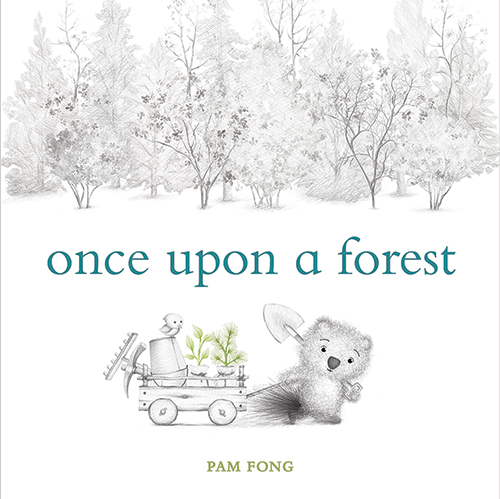
Once Upon a Forest
Reviewed by Jim Foritano
December 1, 2022
By Pam Fong. Random House Studio, 2022. 40 pages. $17.99/hardcover; $10.99/eBook. Recommended for ages 4–8.
I’ve always loved reviewing children’s books, not only for their direct story lines but also for their art, which so often expands the dimensions of the story beyond the word and page. At the same time, my reverence for this art recoiled at naming it “illustration,” as if it existed only secondarily to the prose: to signal, as it were, the action in the main ring. It actually is so much more vital to the reader’s experience. So you can imagine how justified I felt in this conviction when I was asked if I might be interested in a book that—apart from its humble title—plays mum in regard to text.
Artist Pam Fong’s two characters, a determined little marmot and her resourceful friend, a little bird, act out their intertwined lives amidst the larger character of a forest; both are nurtured and nurturing without one word passing between them. How odd, you may say, animals are usually so eloquent—from folk tales to Dr. Suess! And yet, even without an explicit story line, Fong’s animals speak volumes by only the artistry devoted to their attention and actions. Though they don’t have names, both the feathered and the furred stand out on the strength of their personalities and deeds.
Marmot is an actor we first find in a homemade clearing, hefting a watering can almost as big as herself over both needled and leaved tree seedlings. Home peeks out from the edge of the first page: a no-nonsense lodge of bamboo tubes lashed together with what look to be sturdy vines—all natural materials in a form of functional design. The same is true for a birdhouse, where, from the porch, a little bird observes closely, probably the most untroubled moment in this whole saga.
Determined as they both are—bird and marmot—to meet their heavy domestic cares, which are always attended to (one surmises by their alert postures), we viewers are the first to notice a tendril of smoke, diaphanous and deadly, winding its way into our clearing on the very top of the second page. But no sooner than we are wrapped in watchful wonder by this, we are joined on the next page by an equally alert, ready marmot. A still-dripping watering pail stands beside both arms and a body that is already released to attend to an unexpected and urgent interruption. Next a little black nose and eyes are lifted to the ominous sight and smell of dark smoke emerging over the hill.
In the next four panels, a high-tech helicopter is releasing a smudge of blue water into a threatened forest, and we sit on the shoulders of our determined marmot, taking it all in.
If the scenes in the next flow of pages are only halfway true, as they indubitably are, marmots are the equal of Homo sapiens in toolmaking and use. The tools piled in a homemade wagon are put to immediate use defending what’s left to defend by both dark of night and light of day, and through a medley of different seasons with both easy and hard weather!
Before silent films became talkies, successful actors put their emotions into not words but expressions and actions on an operatic scale. Now the determined marmot and her resourceful, winged friend likewise express with eloquence a tale of the joys and perils of our contemporary lives: perils, as we all know, almost too breathless for words. Our two friends with their united, soulful efforts tap out a semaphore of needs that are met together. And we join in without a word wasted, discovering more to see and sense than we ever saw before.
Jim Foritano attends Cambridge (Mass.) Meeting.



Comments on Friendsjournal.org may be used in the Forum of the print magazine and may be edited for length and clarity.